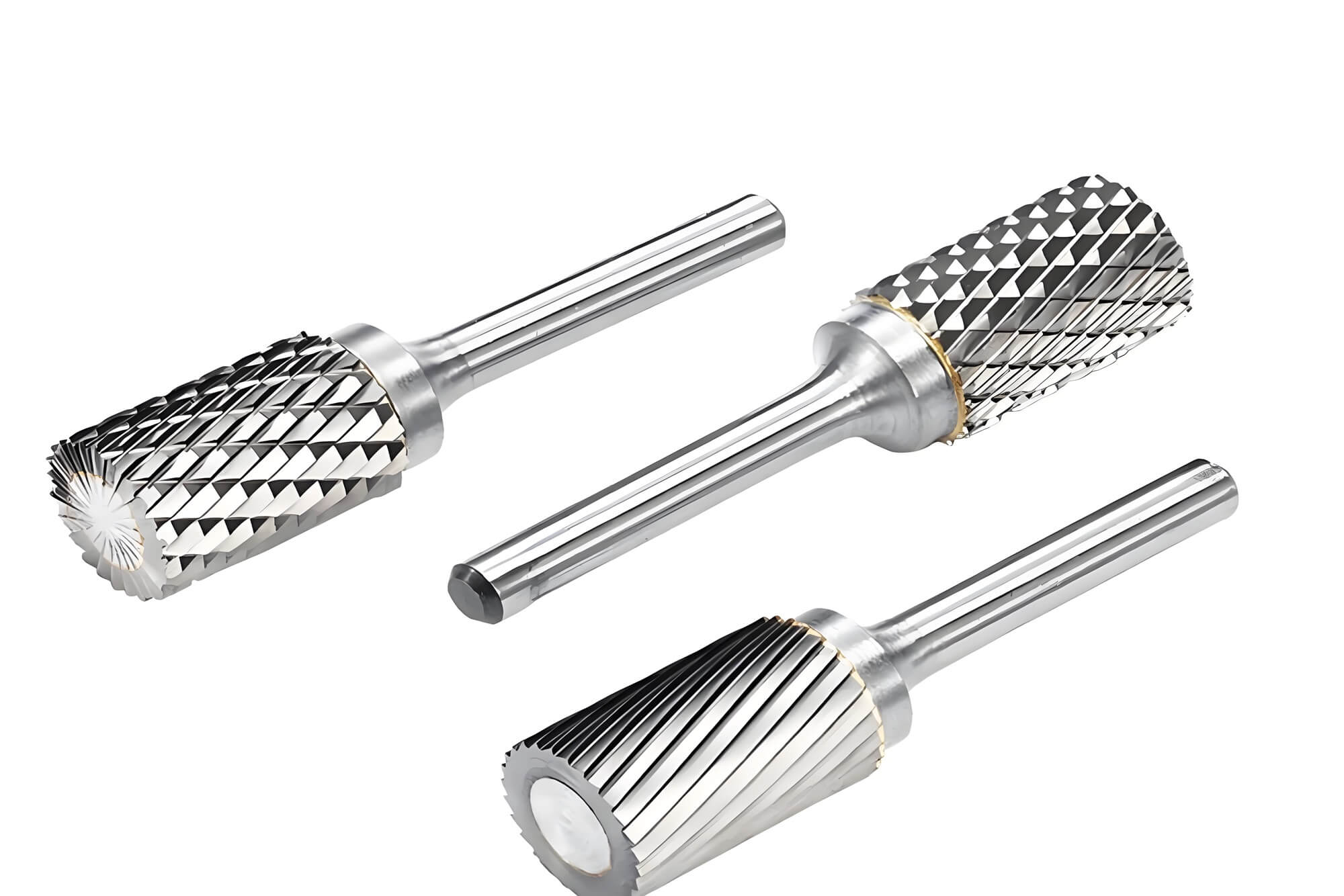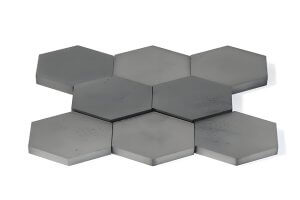Introduction: The Transformative Power of Carbide Burrs in CNC Machining
In the fast-evolving realm of CNC machining, where precision, automation, and efficiency are paramount, the carbide burr—often referred to as a tungsten carbide rotary file—has become a cornerstone for achieving superior finishes. As a CNC process engineer with 15 years of experience in aerospace and automotive manufacturing, I’ve seen carbide burrs evolve from niche tools to indispensable assets in CNC machining. From deburring intricate titanium components to sculpting complex composite molds, carbide burrs deliver unmatched versatility. This in-depth guide explores their material science, geometric diversity, and operational strategies, enriched with my firsthand insights and practical tips.
Part 1: The Science Behind Carbide Burr Performance
Understanding the material and design of carbide burrs is the foundation for unlocking their potential in CNC machining.
1.1 The Role of Carbide Burrs in CNC Machining
A carbide burr is a rotary cutting tool engineered for precision shaping, grinding, and deburring in CNC machining. Its construction combines a tungsten carbide cutting head with a steel shank, balancing hardness with durability. Early in my career, while programming a 5-axis CNC for aerospace fittings, I was struck by how carbide burrs effortlessly smoothed complex contours where end mills struggled. Unlike tools designed for bulk material removal, carbide burrs excel in finishing, making them ideal for automated CNC machining on machining centers or robotic systems. Their precision under high-speed conditions has transformed my approach to finishing tasks.
1.2 Tungsten Carbide vs. High-Speed Steel: A Shop-Floor Perspective
The material of a carbide burr shapes its performance in CNC machining. Tungsten carbide (TC) outperforms high-speed steel (HSS) in ways that have redefined my tool selection. TC carbide burrs achieve hardness levels of HRA 89-95 (HRC 69-81), far surpassing HSS’s HRC 62-65, ensuring longer tool life. I recall a project machining stainless steel turbine blades where TC carbide burrs lasted 15 times longer than HSS, saving significant costs. Additionally, TC’s thermal stability up to 900-1000°C allows carbide burrs to thrive in high-RPM CNC machining, unlike HSS, which softens at ~600°C. While TC’s brittleness requires careful handling, the rigid setup of CNC machining minimizes this drawback, making carbide burrs the superior choice.
Table 1: Tungsten Carbide vs. High-Speed Steel in CNC Machining
| Property | Tungsten Carbide (TC) | High-Speed Steel (HSS) |
| Hardness | HRA 89-95 | HRC 62-65 |
| Max. Effective Temp. | ~900-1000°C | ~600°C |
| Toughness/Brittleness | More Brittle | More Tough |
| Initial Cost | Higher | Lower |
| Ideal Application | High-speed CNC machining finishing | Low-speed, toughness-driven tasks |
1.3 Decoding Carbide Burr Cut Types
The cut type of a carbide burr determines its effectiveness in CNC machining. Single-cut carbide burrs, with a single spiral flute, are ideal for heavy stock removal on ferrous metals like cast iron, producing long chips for roughing. Double-cut carbide burrs, with intersecting flutes, create small chips, offering versatility for metals and plastics. I’ve used them to achieve polished finishes on aluminum aerospace parts. Aluma-cut carbide burrs, designed for non-ferrous metals, feature open flutes to prevent chip loading. During a copper housing project, switching to an aluma-cut carbide burr eliminated clogging issues, streamlining the process.
Part 2: Carbide Burr Shapes and Their CNC Machining Applications
Selecting the right carbide burr shape is critical for optimizing CNC machining tasks.
2.1 Matching Carbide Burr Shapes to Tasks
Each carbide burr shape is engineered for specific CNC machining applications, as I’ve learned through years of programming multi-axis systems. Cylindrical carbide burrs (SA/SB/SC) excel in flat surface finishing and fillet blending, versatile across metals and composites. Ball-shaped carbide burrs (SD) are perfect for 3D carving and hole deburring, offering omnidirectional cutting. Oval carbide burrs (SE) smooth rounded transitions, while tree-shaped carbide burrs (SF/SG) access tight areas for weld seam blending. Flame carbide burrs (SH) sculpt irregular surfaces, and cone carbide burrs (SJ/SK/SM) ensure precise chamfering. Inverted cone carbide burrs (SN) tackle back-side features, a niche but critical capability.
Table 2: Carbide Burr Shape Applications in CNC Machining
| Shape (Code) | Primary CNC Machining Application | Key Geometric Advantage | Ideal Materials |
| Cylinder (SA/SB/SC) | Flat surface finishing, fillet blending | Versatile for flat and curved surfaces | All metals, composites |
| Ball (SD) | 3D carving, hole deburring, cavity work | Omnidirectional cutting | All metals, wood, stone |
| Oval/Egg (SE) | Edge rounding, groove creation | Smooth arc for rounded transitions | All metals, plastics |
| Tree (SF/SG) | Weld seam blending, V-groove deburring | Tapered access to tight areas | All metals, composites |
| Flame (SH) | Sculpting, tapered groove contouring | Streamlined for irregular surfaces | All metals, wood |
| Cone (SJ/SK/SM) | Chamfering, countersinking | Precise angle control | All metals |
| Inverted Cone (SN) | V-cuts, back-side chamfering | Access to underside features | All metals |
2.2 Real-World CNC Machining Scenarios
In my work, carbide burrs have revolutionized CNC machining tasks. For an automotive gear housing project, I programmed cylindrical carbide burrs to deburr edges, achieving consistency that manual methods lacked. On a composite mold for a drone, ball-shaped carbide burrs smoothed 3D contours on a 5-axis CNC, erasing tool marks from prior milling. Tree-shaped carbide burrs cut weld seam finishing time by 40% on steel structures, and a small flame carbide burr enabled precise engraving of logos on titanium parts, delivering details unattainable with other tools. These applications highlight how carbide burrs turn manual artistry into automated precision.
Part 3: Mastering Carbide Burrs in CNC Machining
Optimizing carbide burrs in CNC machining requires a blend of technical knowledge and practical experience.
3.1 Fine-Tuning Speed and Feed
Spindle speed for carbide burrs hinges on diameter and material, targeting optimal surface feet per minute (SFPM). I’ve found that adhering to recommended RPMs prevents tool wear and ensures quality finishes. For example, running a 6 mm carbide burr at 40,000 RPM on aluminum delivered smooth results without overheating.
Table 3: Recommended RPM for Carbide Burrs in CNC Machining
| Burr Diameter | Steel/Hard Metals | Aluminum/Soft Metals | Titanium/Superalloys | Composites/Plastics |
| 3 mm (1/8″) | 60,000-80,000 | 70,000-90,000 | 60,000-80,000 | 70,000-90,000 |
| 6 mm (1/4″) | 35,000-45,000 | 40,000-50,000 | 30,000-45,000 | 40,000-50,000 |
| 10 mm (3/8″) | 22,500-35,000 | 25,000-40,000 | 19,000-30,000 | 25,000-40,000 |
| 12 mm (1/2″) | 20,500-30,000 | 22,000-35,000 | 15,000-22,500 | 22,000-35,000 |
Feed rates for carbide burrs should start conservative, adjusted based on cutting sound and surface quality. In a brass project, a light feed prevented chatter, ensuring a mirror-like finish.
3.2 Depth and Width of Cut Strategies
For finishing with carbide burrs, I prioritize shallow depths of cut (DOC) and widths of cut (WOC) to maintain surface quality. In a titanium job, multiple light passes with a carbide burr avoided work hardening, unlike a heavy cut that caused tool failure. This approach ensures consistent results in CNC machining.
3.3 Eliminating Chatter
Chatter can sabotage carbide burr performance in CNC machining. I minimize overhang by using short carbide burrs with deep shank insertion, enhancing rigidity. Secure workpiece fixturing is critical—a loose part once caused chatter in a mold project, resolved by robust clamping. Adjusting RPM by 5-10% often shifts the process out of resonant frequencies, and high-quality holders like shrink-fit models reduce runout, ensuring smooth operation.
Part 4: Material-Specific Strategies for Carbide Burrs
Tailoring carbide burr selection to materials is key to success in CNC machining.
4.1 Ferrous Metals
Double-cut carbide burrs are my default for steel and stainless steel, balancing stock removal and finish quality. For hardened steels (HRC >50), single-cut carbide burrs tackle aggressive cuts. Coolant is essential for stainless steel to manage heat, while cast iron can be machined dry with robust dust extraction, as I learned in a heavy-duty casting project.
4.2 Non-Ferrous Metals
Aluma-cut carbide burrs prevent clogging in aluminum and brass. A past mistake using a double-cut carbide burr on aluminum taught me the value of open flutes. Lubricants like cutting oil reduce adhesion, and high RPM with moderate feed ensures clean CNC machining results.
4.3 Advanced Materials
Diamond-cut carbide burrs are critical for titanium and superalloys, resisting extreme abrasion. Low RPM, high-pressure coolant, and rigid setups prevent work hardening. A titanium job early in my career failed due to inadequate cooling, underscoring the need for precise heat management.
4.4 Plastics and Composites
Single-cut carbide burrs shear plastics cleanly, while diamond-coated carbide burrs handle abrasive composites like CFRP. High-speed cuts with dust extraction prevent melting or delamination. A composite project taught me the importance of dust control after tool wear from neglected extraction.
Part 5: Maximizing Carbide Burr Longevity and Safety
5.1 Extending Tool Life
Selecting the right carbide burr for the material is the first step to longevity. Low-runout holders and proper coolant use reduce wear in CNC machining. I clean carbide burrs post-use and store them in protective cases to prevent edge damage, a habit formed after chipping a costly tool due to careless storage.
5.2 Ensuring Safety
Enclosed CNC machines contain chips and potential carbide burr fragments. Secure shank clamping prevents accidents—I’ve seen a loose carbide burr damage a spindle. Safety glasses and gloves are mandatory, and dust extraction is critical for composites to protect health.
Part 6: Personal Reflections and Shop-Floor Stories
My journey with carbide burrs in CNC machining has been a masterclass in precision. One memorable project involved a carbon fiber aerospace component. Initial attempts with an end mill caused delamination, but a diamond-coated carbide burr on a 5-axis CNC delivered a flawless finish, earning client praise. Another lesson came from a stainless steel valve job where excessive feed led to chatter. Switching to a double-cut carbide burr and lighter parameters restored quality. These experiences highlight the need for adaptability and precision in CNC machining.For those new to carbide burrs, I recommend starting with double-cut models and testing on scrap material to dial in settings. Resources like want.net provide high-quality carbide burrs and expert guidance, which I’ve found invaluable for sourcing tools that elevate CNC machining performance.
Conclusion
The carbide burr is a linchpin in CNC machining, transforming finishing tasks into precise, automated processes. By mastering their materials, shapes, and parameters, you can achieve exceptional quality and efficiency. My years on the shop floor have shown that carbide burrs are not just tools but solutions to complex challenges. For top-tier carbide burrs and insights, I recommend exploring want.net, a trusted resource for optimizing your CNC machining workflow. Embrace carbide burrs to redefine manufacturing excellence.
FAQ:
1. What is a carbide burr and its role in CNC machining?A carbide burr, also known as a hardened alloy milling head, is a precision rotary tool used in CNC machining for tasks like deburring, shaping, grinding, and surface finishing. Unlike traditional milling tools, carbide burrs excel in detailed finishing, making them essential for achieving high-quality results in automated CNC machining processes, such as smoothing complex contours or removing burrs from intricate parts.
2. How do I select the right carbide burr for my CNC machining project?Choosing the right carbide burr depends on the material, task, and desired finish. For example, double-cut carbide burrs are versatile for metals and plastics, while aluma-cut hardened alloy milling heads prevent clogging in aluminum. Shapes like ball carbide burrs suit 3D contouring, and cylindrical ones are ideal for flat surfaces. Always match the carbide burr to the material and refer to application matrices (like Table 2) for guidance.
3. What are the optimal speeds for carbide burrs in CNC machining?The spindle speed (RPM) for carbide burrs varies by diameter and material to maintain optimal surface feet per minute (SFPM). For instance, a 6 mm hardened alloy milling head runs at 35,000-45,000 RPM for steel and 40,000-50,000 RPM for aluminum (see Table 3). Incorrect speeds can lead to tool wear or poor finishes, so always adjust based on material and CNC machining conditions.
4. How can I extend the life of my carbide burr in CNC machining?To maximize carbide burr longevity, select the correct cut type and shape for the material, use low-runout tool holders, and apply coolant to reduce thermal wear. After use, clean the hardened alloy milling head to remove debris and store it in a protective case. Proper fixturing and conservative feed rates also prevent premature wear in CNC machining.
5. Why do carbide burrs outperform other tools in CNC machining?Carbide burrs, made from tungsten carbide, offer superior hardness (HRA 89-95) and thermal stability (up to 900-1000°C) compared to high-speed steel (HSS). This allows hardened alloy milling heads to maintain sharp edges at high RPMs, ideal for CNC machining tasks like deburring and contouring. Their durability reduces tool changes, boosting efficiency.
6. How do I prevent chatter when using carbide burrs in CNC machining?Chatter, a vibration that degrades finishes, can be minimized by reducing tool overhang with short carbide burrs, ensuring rigid workpiece fixturing, and adjusting RPM by 5-10% to avoid resonant frequencies. High-quality tool holders, like shrink-fit models, also reduce runout, ensuring stable CNC machining with hardened alloy milling heads.
Reference:
https://en.wikipedia.org/wiki/Burr_(cutter)
https://commons.wikimedia.org/wiki/Cutting_tool
https://en.wikipedia.org/wiki/Burr
Other Articles You Might Enjoy
- Cemented Carbide: The Material Science and Application Strategies Driving High-Performance CNC Machining
Part 1: The Material Science of Cemented Carbide: The Core of CNC Machining As a machinist with 15 years of experience, I’ve come to appreciate cemented carbide as the unsung…
- Silicon Carbide and CNC Machining: A Comprehensive Technical Analysis of Materials, Processes, and Applications
Introduction Silicon carbide (SiC) stands as a pinnacle of advanced ceramics, engineered to thrive in environments that push materials to their limits. Its extraordinary hardness, thermal resilience, and chemical stability…
- The Carbide Scraper in CNC Machining: A Strategic Approach to Precision Finishing and Workflow Optimization
Introduction: Elevating CNC Machining with the Carbide Scraper In the fast-paced world of CNC machining, where precision defines success, the carbide scraper is often misunderstood as a rudimentary tool for…
- Beyond Steel: The Science and Strategy of Carbide Drill Bits in Modern CNC Machining
In the high-stakes world of CNC machining, where precision, speed, and cost-efficiency collide, carbide drill bits have become the unsung heroes of high-performance holemaking. As a machinist with over a…
- Machining the 'Black Diamond': A Comprehensive Guide to Advanced CNC Techniques for Boron Carbide
Boron carbide, often hailed as the "black diamond," is an advanced ceramic renowned for its extraordinary hardness, surpassed only by diamond and cubic boron nitride (cBN). Its unique blend of…






